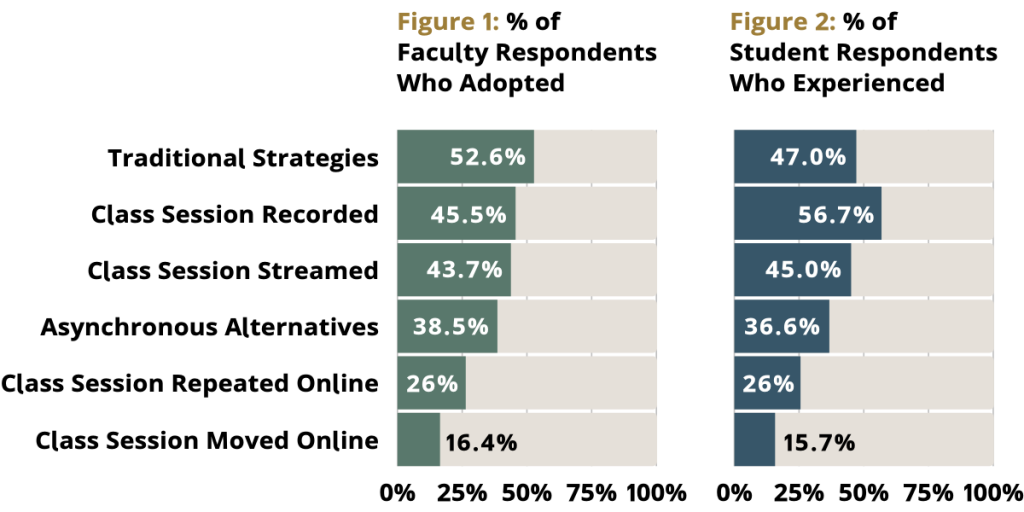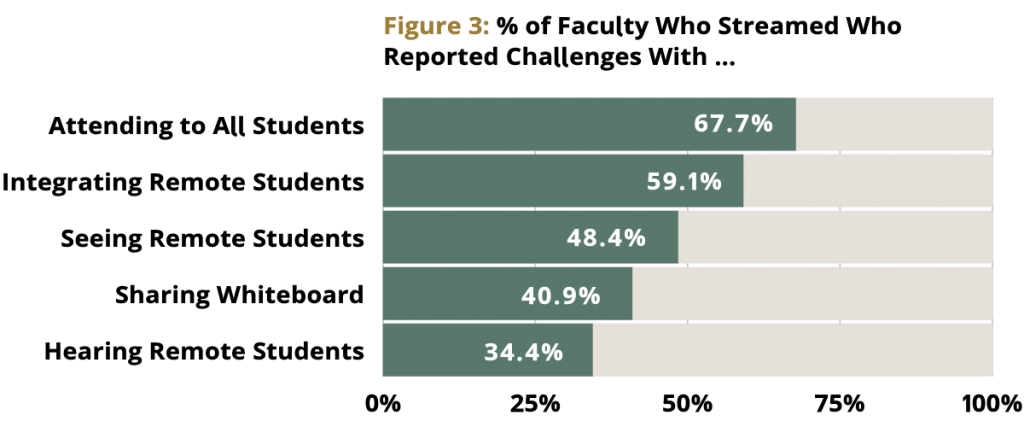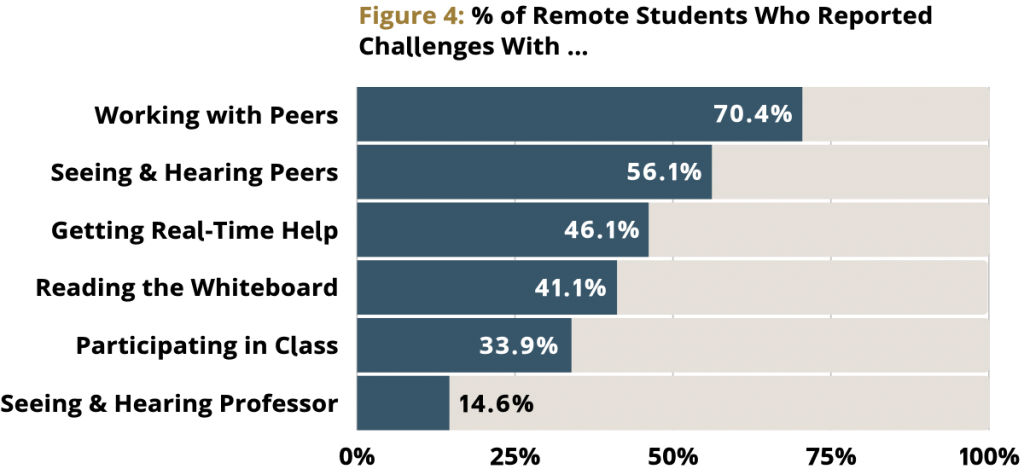Strategies for Accommodating Students: Spring 2021 Update

*Note this is an updated version of our previous blog post from October 26, 2020. The information here discusses what we learned from our Fall survey of students and faculty and also new resources available in Spring 2021. The entire CAT Team contributed to this post.
Given the recent spike in cases of COVID-19 on campus, many of you may be dealing with students in isolation or quarantine. In this post from the fall, we suggested options for both synchronous and asynchronous accommodations. That post is still worth a read, but we wanted to follow up here with information we learned from our fall survey as well as new resources available.
Before we dive in, we want to preface this post by noting that there is no perfect solution in this scenario. We know you want to meet the needs of your in-person students, your students in isolation and quarantine, and your own needs as an instructor. Yet no solution meets all of these needs perfectly and each has its own set of challenges. As a result, we encourage you to examine the following strategies and decide which challenges are right for you given your course, your students, and your own personal capacity. Whatever you decide, we encourage you to be in constant communication with your students. Explain what you’ve chosen and why, and ask them for feedback about how your solutions are (or are not) working.
Fall Survey Results
Let’s start with what we learned from our fall survey of both students and faculty. We asked both about strategies utilized when students could not attend class in-person.

As you can see from Figures 1 & 2, faculty adopted various strategies to accommodate students in isolation and quarantine. The most common approach was to work with students as we traditionally would when they experience extended absences (e.g., making notes available and meeting for 1:1 office hours). Qualitative feedback from the survey suggests that this approach (letting students focus on rest and recovery) was one of the most successful. Likewise, those who had designed their courses in advance with asynchronous alternatives already built-in seemed to have few issues accommodating these students. Instructors who chose to record or stream their in-person classes reported more challenges (more about this below).
How Do Students Experience Quarantine?
Before we get into specific accommodation strategies, let’s take a quick detour to talk about the toll quarantine can take on our students. We have seen our colleagues go to extraordinary lengths to work with our students over the last few semesters. Yet we’ve also learned that our students face many challenges that are sometimes invisible to us in the classroom. Open-ended comments made clear that isolation and quarantine have taken a toll on our students’ mental health.
Teachers need to be more understanding about students going to the COVID hotel and the mental impact that it has. I had to go three times during the semester, and I was so depressed that I couldn’t make myself do work.
While it’s important to figure out strategies to allow our students to continue their coursework, it’s important to remember that keeping up with coursework is not their only (or primary) challenge in isolation and quarantine. The recent spike in cases and the resulting necessity to adjust procedures for isolation and quarantine may further contribute to students’ mental health challenges.
You can learn a lot about what students typically experience by visiting the Quarantine and Isolation site for students. The site also provides information we can share with students. In particular, we can encourage students to take advantage of wellbeing support, such as personalized outreach, a weekly support and connection group, and a 1:1 session with a Wellbeing coach. Students need to opt-in to this support, so a simple check-in email from you asking how they are doing and referring them to these resources can go a long way. Just remember that student health information is private, so unless they tell you directly, you shouldn’t ask if they are in quarantine, isolation, or have COVID.
Accommodation Strategies
Traditional Strategies
A simple solution might be to use traditional strategies that you have used in the past for students who needed to be absent for an extended period of time. This might include sharing lecture notes/slides, 1-on-1 meetings, or other means of allowing students to catch up later. If you don’t have many students out, this might be an easy solution that does not require a lot of additional effort on your part. It also allows students who are sick time to rest and recover.
Asynchronous Strategies
Another option is to provide students with some type of asynchronous alternative that would be comparable or achieve the same learning goals for in-class time. They can then complete them on their own or with other students who are absent. For example, if your class is discussion-based, can you have quarantined students participate in an online discussion instead of coming to class? If there are enough of them, perhaps they could meet online in Zoom, record their discussion or group work (with some advance instructions from you) and submit the recording to you in lieu of attending class?
Offer Additional Class Sessions
If there are enough students who need to be absent, is it worthwhile to repeat the class online synchronously in Zoom or WebEx for this group? We acknowledge this requires more time on your part, but present it as an option since it appears that others used this strategy in the fall. Also, in theory, it should only require the additional time it takes to hold the class which may feel like a more attractive alternative to some than creating new asynchronous activities that may need to be monitored and graded.
Record the Class for Later Viewing
For our colleagues in the Law and Business Schools, your schools have put processes in place to assist with recording your in-person classes to post for later viewing. If you are a colleague in the College, Divinity, or Graduate school, there is a new process for requesting a limited number of self-service video kits to make this happen (see information at the end of this post). There are a limited number of these kits and this is meant to serve as a temporary solution.
If you choose this alternative, we recommend that you add some type of engagement or interaction element to go along with viewing the lecture. That might be embedding questions throughout for the students or simply giving them some type of worksheet or gap handout to work through while watching the recording.
Live Stream the Class
Some of our colleagues chose to use technology to stream in-person class sessions to isolated and quarantined students. Some chose to make this a one-way stream out to online students, while others attempted to include online students in in-person activities.
In our fall survey, we asked some specific questions about streaming which may be helpful for you to know if you are considering this option. Faculty who chose to stream their courses reported challenges with attending to all students and with integrating remote students, in particular. They also had difficulties seeing and hearing remote students as well as sharing the whiteboard. So, while it is possible to have active, engaged classrooms while streaming, it takes a lot of planning to try to make dual-delivery work.

Similarly, both remote and in-person students reported challenges with streaming. They had difficulty working with peers, seeing and hearing peers and the instructor, getting real-time help, reading the whiteboard, and just generally participating in the class.


I was not a fan of courses that made students attend class in person or online in groups. When I was in person, I couldn’t hear my classmates attending via zoom, and when I used headphones, I was hearing the professor double. I would hear his voice in the room, but also hear it through zoom in a delay, and it made it very hard to focus.
Based upon the findings of the survey, we recommend that you record your class session and make it available for students after class rather than live streaming and having them attend in real-time. Doing so eliminates the above challenges and also avoids privacy issues that might arise if you ask students to attend a live class session from isolation or quarantine. That said, if you determine this solution is the best for your students and your class, the class video recording kits make this streaming possible (information below).
Move Your Entire Class Online
Finally, if there is a high threshold of students in quarantine and isolation, you might be considering moving your whole class online. While this is understandable, please remember that for many of our students, attending their in-person classes is one of the few opportunities they have to leave their residences and interact with others. They value that time with their fellow students and instructors.
If ultimately you decide this is the best option for your class, we recommend that you be in communication with your chair and keep them informed.
Summary
Yet again, we find ourselves saying “this is hard.” It’s hard for us and it’s hard for students. Try to respond to the situation with empathy (both for your students and yourself), pick a solution that works best for your specific situation, focus on implementing it well, and communicate your intentions to your students.
If you’re struggling to decide on an approach, feel free to reach out and schedule a consultation with one of us.
Class Video Recording Kit Information
This spring, faculty in the College, Divinity, and/or Graduate school will have access to class video recording kits which can be used to capture in-person class sessions or broadcast a live class. These kits are a significant improvement over attempting to use a laptop webcam to record a class session or open a Zoom session on a laptop because they provide superior audio and video quality and control. While the kits are relatively straightforward to operate, it is important to have a bit of time to get comfortable with them and set them up in the classroom in order to optimize the video and audio.
Because there are a limited number of these kits, they are available on a first-come, first-served basis and will be prioritized for short term use to support classes with significant numbers of students in quarantine or isolation. If you are interested in using a classroom recording kit, please use this form to get started. This tip sheet provides pedagogical and accessibility suggestions for effectively using these kits. Should one of these video recording kits sound potentially useful for additional pedagogical situations, please also reach out to the classroom video kit project team (including members of the CAT, IS, and the ITG) via the form.
Subscribe
Receive CAT blog posts in your inbox.
